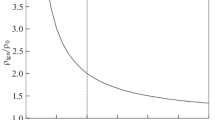Abstract
The kinetics of NO and NO2 of behind shock fronts propagating in air are analyzed. It is shown that in certain cases it is necessary to use fairly detailed chemical reaction schemes involving not only N2, O2, NO, N, and O, but also NO2, N2O, H2, OH, and H and to take into account the mutual effects of vibrational relaxation and chemical transformations. It is established that neglecting the chemical processes involving NO2 only can lead to significant errors in the length of the relaxation zone (up to 25 times), the gasdynamic parameters (up to 20%), and the NO concentration (up to 3 times).
Similar content being viewed by others
References
Yu. A. Gostintsev and Yu. V. Gamera, “Generation of nitrogen oxides in a strong air explosion. Interaction between NO x and the ozone layer,”Chim. Fiz.,13, No. 2, 109 (1994).
G. C. Goldenbaum and R. R. Dickerson, “Nitric oxide production by lightning discharges,”J. Geophys. Res.,98, No.D10, 18.333 (1993).
C. Park,Nonequilibrium Hypersonic Aerothermodynamics, Wiley, N. Y. (1990).
G. A. Tirsky, “Up-to-date gasdynamic models of hypersonic aerodynamics and heat transfer with real gas properties,”Annu. Rev. Fluid Mech.,25, 151 (1993).
H. K. Cheng and G. Emanuel, “Perspective on hypersonic nonequilibrium flow,”AIAA Journal,33, 386 (1995).
O. Knab, T. H. Gogel, H.-H. Frühauf, and E. W. Messerschmid, “CVCV-model validation by means of radiative heating calculations,”AIAA Paper, No. 95-0623 (1995).
O. Knab, H.-H. Frühauf, and E. W. Messerschmid, “Theory and validation of physically consistent coupled vibration-chemistry vibration model,”J. Thermophys. and Heat Transfer,9, No. 2, 219 (1995).
S. A. Losev, V. N. Makarov, and M. Yu. Pogosbekyan, “Model of physico-chemical kinetics behind the front of a very strong shock wave in air,”Izv. Ros. Akad. Nauk, Mekh. Zhidk. Gaza, No. 2, 169 (1995).
A. I. Osipov and A. V. Uvarov, “Kinetic and gasdynamic processes in nonequilibrium molecular physics,”Usp. Fiz. Nauk,162, No. 11, 1 (1992).
E. V. Stupochenko, S. A. Losev, and A. I. Osipov,Relaxation Processes in Shock Waves [in Russian], Nauka, Moscow (1965).
E. A. Kovach, S. A. Losev, and A. L. Sergievskaya, “Two-temperature chemical kinetics models for describing molecular dissociation in strong shock waves,”Chim. Fiz.,14, No. 9, 44 (1995).
S. A. Losev, A. L. Sergievskaya, V. D. Rusanov at el., “Nonequilibrium factor in two-temperature dissociation kinetics behind a shock front,”Dokl. Ros. Akad Nauk,346, 192 (1996).
N. M. Kuznetsov,Kinetics of Monomolecular Reactions [in Russian], Nauka, Moscow (1982).
N. G. Dautov and A. M. Starik, “Influence of excitation of molecular vibrations on the dynamics of combustion of a H2 + O2 mixture behind a detonation shock wave,”Zh. Prikl. Mekh. Tekh. Fiz.,36, No. 6, 25 (1995).
T. Shimazaki, “The photochemical time constants of minor constituents and their families in the middle atmosphere,”J. Atmosph. Terr. Phys.,46, No. 2, 173 (1984).
A. M. Starik and N. G. Dautov, “Influence of the vibrational excitation of molecules on the dynamics of combustion of mixtures,”Kinetika i Kataliz,37, 346 (1996).
V. N. Makarov, “Kinetics of physico-chemical processes in high-temperature air,”Teplofiz. Vysok. Temp.,33, 583 (1995).
Yu. A. Kulagin, “Active media for gasdynamic lasers,”Tr. FIAN,107, 110 (1979).
V.A. Sal’nikov and A. M. Starik, “Numerical analysis of energy characteristics of gasdynamic lasers operating on hydrocarbon fuel combustion products,”Teplofiz. Vysok. Temp.,33, 121 (1995).
Additional information
Moscow. Translated from Izvestiya Rossiiskoi Akademii Nauk, Mekhanika Zhidkosti i Gaza, No. 1, pp. 132–144, January–February, 1999.
The work was carried out with financial support from the Russian Foundation for Basic Research (project No. 96-02-18377).
Rights and permissions
About this article
Cite this article
Starik, A.M., Titova, N.S. Features of nonequilibrium processes of titrogen oxide formation behind strong shock waves in air. Fluid Dyn 34, 110–120 (1999). https://doi.org/10.1007/BF02698759
Received:
Issue Date:
DOI: https://doi.org/10.1007/BF02698759



